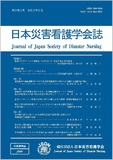Japanese
English
- 有料閲覧
- Abstract 文献概要
- 参考文献 Reference
要約
目的:北陸地方の福祉避難所の要配慮者の受け入れ体制と、施設の立地特性を明らかにすること。
方法:北陸地方の福祉避難所のうち、施設属性、立地特性、要配慮者の受入れ体制に回答が得られた施設管理者131人を対象とし、質問紙調査を実施した。立地特性はGISを用いて解析した。
結果:福祉避難所の未公表は3自治体だった。衛星電話を備えていたのは1施設、バックアップ電源は58.0%だった。浸水想定区域に23.7%が立地し、土砂災害警戒区域に8.4%が立地していた。浸水区域外から内に要配慮者が移動する負の誘導効果のリスクのある施設は3施設だった。
結論:1施設を除き、携帯電話とインターネット回線の途絶により通信手段を喪失し、約4割が、電源が必須な要配慮者の受入れはできない。河川氾濫時の浸水想定及び土砂災害警戒区域に立地する施設は、二次避難所としての福祉避難所の役割を果たすことはできない。
Objectives: The objective of this study was to evaluate the eligibility criteria and location characteristics of evacuation shelters for people vulnerable to disasters in the Hokuriku region.
Methods: We conducted a questionnaire survey of 131 such evacuation shelter managers concerning the facility attributes, location characteristics, and eligibility criteria. The location characteristics were analyzed using a geographic information system.
Results: Among the municipalities in the Hokuriku region, three did not disclose the existence of evacuation shelters for people vulnerable to disasters to their residents. Only one shelter was equipped with a satellite phone; 58.0% of the shelters had a backup power supply; 23.7% of the shelters were located in areas where inundation can be expected; 8.4% of the shelters were located in areas where debris flow and landslides may occur. Evacuation to three of the facilities would lead to the movement of people into areas under flooding threats.
Conclusions: Most shelters would lose their means of communication if mobile phone and internet services were disrupted. About 40% of the facilities do not have power supply and cannot accommodate those in need. Facilities located in areas where flooding is anticipated or debris flow and landslides may occur cannot serve as secondary shelters.
Copyright © 2020, Japan Society of Disaster Nursing All rights reserved.


